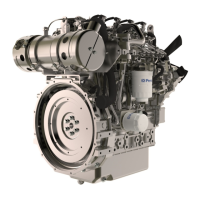4. Allow the keyswitch to return to the RUN position
after the engine starts.
5. Repeat step 2 through step 4 if the engine fails to
start.
Note: The engine should not be “raced” to speed up
the warm-up process.
6. Allow the engine to idle for 3 to 5 minutes, or allow
the engine to idle until the water temperature
indicator begins to rise. When idling after the
engine has started in cold weather, increase the
engine rpm from 1000 to 1200 rpm. This operation
will warm up the engine more quickly. Maintaining
an elevated low idle speed for extended periods
will be easier with the installation of a hand
throttle.
7. Operate the engine at low load until all systems
reach operating temperature. Check the gauges
during the warm-up period.
8. Constant speed engines could be allowed to reach
operating speed with no load. Operate engine for
2 minutes before applying load.
i06283179
Starting the Engine
Do not use aerosol types of starting aids such as
ether. Such use could result in an explosion and
personal injury.
Note: Do not adjust the engine speed control during
start-up. The electronic control module (ECM) will
control the engine speed during start-up.
Starting the Engine
1. Disengage any equipment that is driven by the
engine.
Note: During key ON, the indicator lamps will be
illuminated for 0.5 of a second to check the lamp
operation. If any of the indicator lamps do not
illuminate check the bulb. If any indicator lamps stay
illuminated or flash, refer to Troubleshooting,
“Indicator Lamp Circuit - Test”.
2. Turn the keyswitch to the RUN position. Leave the
keyswitch in the RUN position until the warning
light for the glow plugs is extinguished.
3. When the warning light for the glow plugs has
been extinguished turn the keyswitch to the
START position. The starter motor will then crank
the engine.
Note: The operating period of the warning light for
the glow plugs will change due to the ambient air
temperature.
NOTICE
Do not engage the starting motor when flywheel is
turning. Do not start the engine under load.
If the engine fails to start within 30 seconds, release
the starter switch or button and wait two minutes to
allow the starting motor to cool before attempting to
start the engine again.
4. Allow the keyswitch to return to the RUN position
after the engine starts.
5. Repeat step 2 through step 4 if the engine fails to
start.
6. Constant speed engines should be allowed to
reach operating speed with no load. Operate
engine for 2 minutes before applying load.
i06092747
Starting with Jump Start
Cables
(Do Not Use This Procedure in
Hazardous Locations that have
Explosive Atmospheres)
The connection of battery cables to a battery and
the disconnection of battery cables from a battery
may cause an explosion which may result in in-
jury or death. The connection and the disconnec-
tion of other electrical equipment may also cause
an explosion which may result in injury or death.
The procedures for the connection and the dis-
connection of battery cables and other electrical
equipment should only be performed in a nonex-
plosive atmosphere.
SEBU9075-03
47
Operation Section
Starting the Engine

